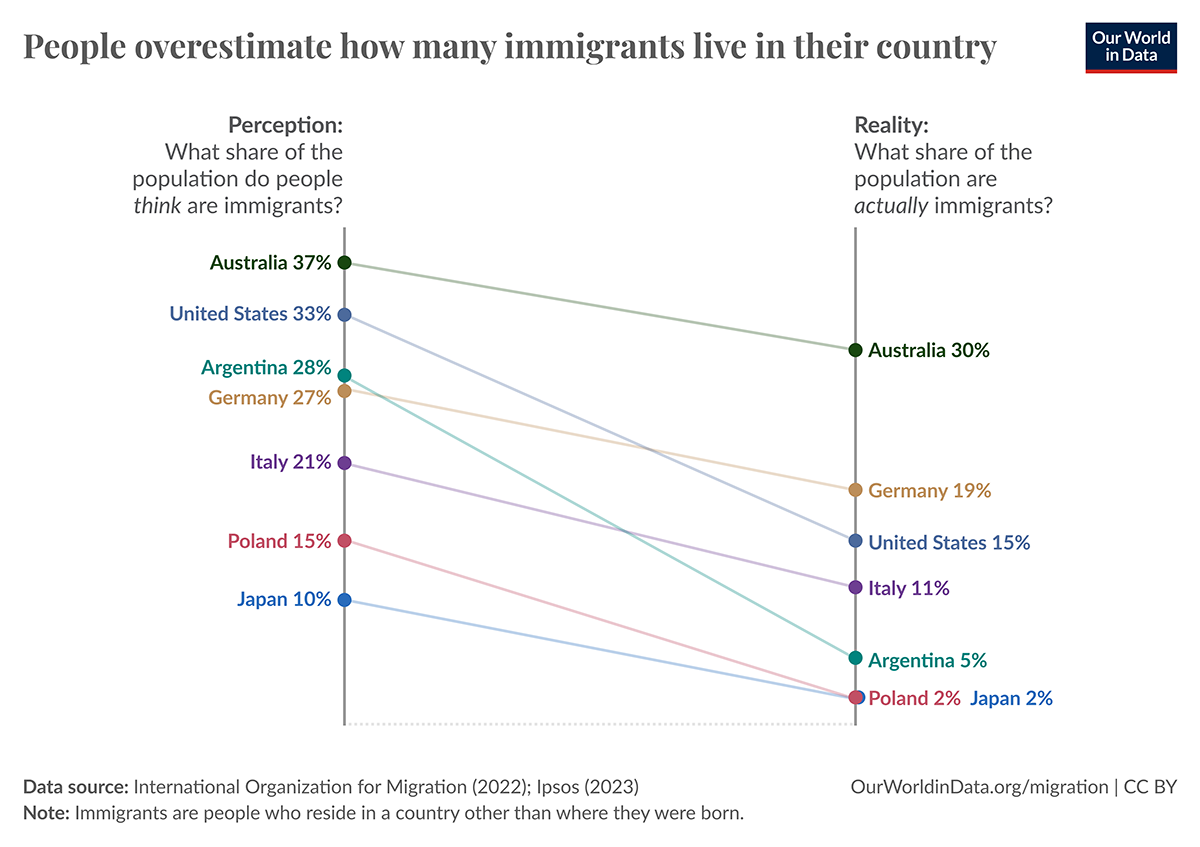Nick Routley
2024-10-31 04:03:00
www.visualcapitalist.com

We often overestimate the number of immigrants in our own countries.
Take the United States, for instance. The average American believes a whopping 33% of the population is foreign-born. Yet, official government figures paint a different picture: the actual percentage is closer to 15%. That’s less than half of what people think.
Japan presents a similar scenario. The public in that country estimates 10% of the population to be immigrants. The reality, however, is much lower: around 2%. That means, for every five immigrants people think exist, there’s only one in actuality.
Here are the numbers on perception versus the actual share of immigrants in selected countries:
| Country | Respondents’ perception of share of immigrants in country | Actual share of immigrants in the country |
 Japan Japan |
10% | 2% |
 Poland Poland |
15% | 2% |
 Argentina Argentina |
28% | 5% |
 Türkiye Türkiye |
25% | 7% |
 Italy Italy |
21% | 11% |
 France France |
23% | 13% |
 United Kingdom United Kingdom |
22% | 14% |
 United States United States |
33% | 15% |
 Germany Germany |
27% | 19% |
 Australia Australia |
37% | 30% |
| Global Average | 24% | 12% |
Of the 10 countries surveyed, Australians had the perception that most closely matched reality. Poland was the country that was the most incorrect about the share of immigrants in the country.
The gap in perception was even more pronounced when respondents were asked to estimate the share of Muslims in their home countries.
The Global Perception Gap
The data for the chart above, made by Our World in Data, comes from Ipsos’ Perils of Perception Report. The report highlights a number of areas where public perception doesn’t match reality. Populations in all the countries surveyed overestimated how much wealth the 1% hold, and erroneously believe that the homicide rate is higher than it was in the year 2000.
So, why does this perception gap exist? When it comes to immigration, a few issues could play a role in warping perception.
Firstly, media coverage and polarization, which sometimes go hand-in-hand, influence how people view immigration.
As well, real life experiences can shape perception. Japan, for example, saw 23 million tourists visit the country in 2023, along with over two million foreign temporary workers living there. So, to Japanese citizens living in major cities, it may feel like there are more immigrants living in the country.
While this global misconception isn’t necessarily harmful, it can influence public policy decisions and become an issue that sways voters come election time.
Source: This data comes from the 2023 Ipsos Perils of Perception report, and the graphic was produced by Our World in Data.
The post Almost Everyone Overestimates How Many immigrants Live in Their Home Country appeared first on Visual Capitalist.
Support Techcratic
If you find value in Techcratic’s insights and articles, consider supporting us with Bitcoin. Your support helps me, as a solo operator, continue delivering high-quality content while managing all the technical aspects, from server maintenance to blog writing, future updates, and improvements. Support Innovation! Thank you.
Bitcoin Address:
bc1qlszw7elx2qahjwvaryh0tkgg8y68enw30gpvge
Please verify this address before sending funds.
Bitcoin QR Code
Simply scan the QR code below to support Techcratic.

Please read the Privacy and Security Disclaimer on how Techcratic handles your support.
Disclaimer: As an Amazon Associate, Techcratic may earn from qualifying purchases.





































![Roblox Pressure | THE RAVEYARD [Full Walkthrough]](https://techcratic.com/wp-content/uploads/2024/12/1734837320_maxresdefault-360x180.jpg)










![[2024 Upgrade] INSAUTO Tesla Model Y Windshield Sunshade Umbrella-Protect Car from Sun…](https://techcratic.com/wp-content/uploads/2024/12/61aJHRkDWTL._AC_SL1392_-360x180.jpg)


















